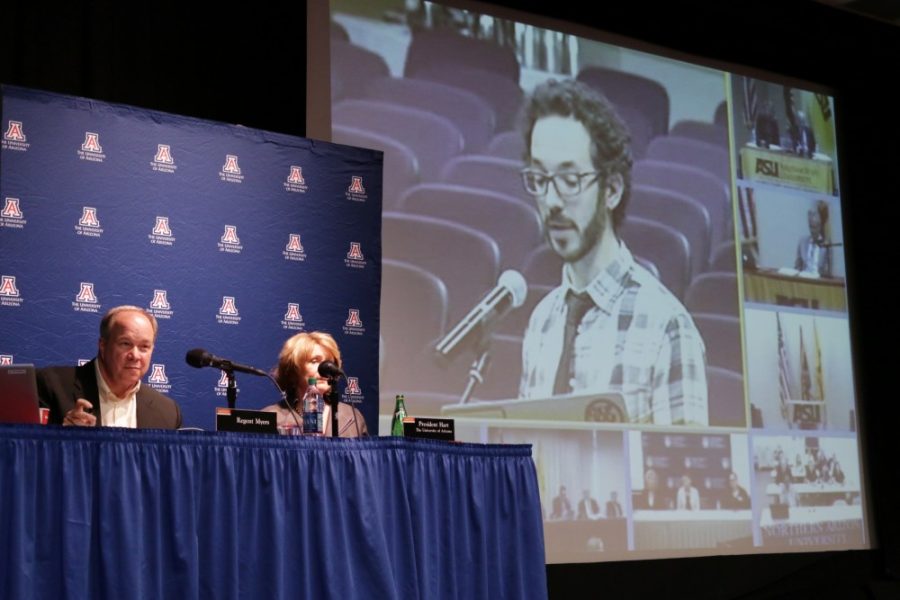The Arizona Board of Regents held an interactive tuition proposal hearing Tuesday night with the three public Arizona universities, live-streaming simultaneous meetings from seven locations across the universities’ multiple campus locations.
The hearing for the main UA campus was held at Gallagher Theater, with the hearing also taking place at the UA South campus in Sierra Vista via live stream.
Regent Rick Myers and UA President Ann Weaver Hart went to the hearing to facilitate and listen to student comments, while Arizona State University President Michael Crow and Northern Arizona University President Rita Cheng made appearances on the live stream.
The UA’s current tuition proposal was released on March 18 and projected a change for all graduate students’ tuition. It will also affect incoming resident and non-resident undergraduate students, and returners who didn’t opt in for the tuition guarantee.
All current undergraduate students who received a tuition guarantee upon entrance to the university will still be asked to pay the same mandatory fees and tuition for all four years, or their remaining years at the UA.
Proposed increases for the 2016-2017 incoming resident undergraduate students are 3.2 percent and 7.2 percent for incoming non-resident undergraduates. For resident graduate students there is a 2.8 percent proposed increase, and for non-resident graduate students a 5.8 percent increase is proposed.
Student leaders including Manny Felix, president of the Associated Students of the University of Arizona, Sarah Netherton, president of the Graduate and Professional Student Council, and Ashley Watkins, president of the Associated Students of the University of Arizona South, were included in tuition discussions with UA administration this year. These talks began taking place right after the holiday break, according to Hart.
Both Felix and Netherton expressed gratitude for being included in these discussions at the main campus Tuesday night.
“Very few student leaders from other universities across the nation have the opportunity to participate in tuition discussions or to be involved in setting the rate of tuition,” Felix said. “Both Sarah Netherton—from GPSC—and I have had the opportunity to work with our university’s leadership where we jointly recommended a tuition rate [increase] of 3 percent.”
Netherton added that beyond suggesting what they saw as a modest tuition increase, herself and Felix engaged in talks with administration and faculty members about accountability.
“Because our student body realizes that as we are burdened with more of the cost of education, we are also in a position to hold our institutions accountable for what they do with that funding and how that comes back to students,” Netherton said. “Particularly when it comes to faculty because one of the expenses that we looked at investing in this year is making sure that we pay our faculty appropriately for the work that they do for us.”
The president of ASUA South differed from other UA student leaders, asking the board to consider UA South’s non-traditional population and the nature of its largest graduate programs, and to offset or decrease the current proposed tuition increases for UA South.
“We are serving a main population of non-traditional students consisting of single parents, part-time working adults, military affiliated individuals, as far as active duty and veterans, and a large minority population,” Watkins said.
She added that many of those in graduate programs were studying elementary education or education administration.
A total of 12 UA students and faculty members spoke at Tuesday night’s hearing from both the main and south campuses.
While much of the criticism from students and faculty was directed at the Arizona State Legislature for its education funding—$99 million was cut from the three state universities in 2015 and Gov. Doug Doucey’s recent proposal passed only $8 million in funding for the coming year—some students also took aim at the regents and the university administration.
Karlyn Bradley, a senior studying gender and women’s studies and political science, accused the regents of not standing up to the state legislature for fear of losing their appointed positions.
He said the work that both the regents and administrators had been doing was easy and not a creative link to the loss of state funding.
“It is easy to say, ‘We have this cost and in order for us to find the money that we need, let’s put it on the students,’ because that is what institutions have always done,” Bradley said.
While the regent and university presidents did not have time to respond to the speakers during the hearing, Hart later said the UA is constantly working to find creative ways to get funding.
She said that while most of the creative changes made to deal with cuts cannot be seen by students, the administration is working to diversify its revenue.
“I understand how it feels but I also think that much of what we are doing has not been visible to the everyday student who is focused on being a good student and succeeding, but I can assure you that we think about this everyday,” Hart said.
The board will officially approve tuition proposals at its meeting on April 7.
Follow Michelle Jaquette on Twitter









